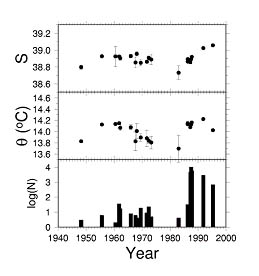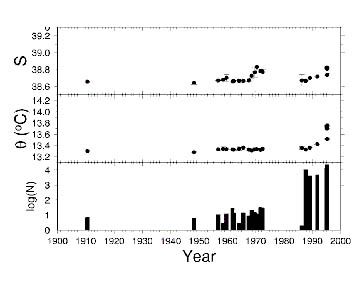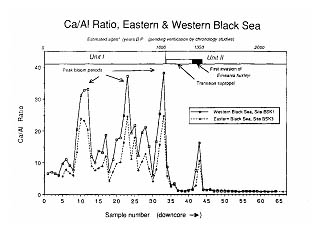

Emin Özsoy
Institute of Marine Sciences
Middle East Technical University
Mersin 33730
Turkey
Extended abstract
The Euro-Mediterranean and Middle Eastern regions together form an interconnected climatic unit. The climates of the 'downstream' water bodies i.e. the Eastern Mediterranean, Black and Caspian Seas, are linked with the climates of the adjoining continents of Europe, Africa and Asia, which are in turn affected by the climates of the adjoining Atlantic and Indian Oceans. Ocean-atmosphere-land interactions and consequent feedbacks between regional and global climate systems could be disproportionately large in this region of contrasts between marine and continental climates, and complex land / sea bottom topography (Özsoy, 1999). High gradients in physical characteristics as well as socio-economics, make the region prone to impacts of climate change, implying possible changes in hydrology and ecosystems. Unexpectedly large impacts could occur, as they have done in the past, in such a complex system, in response to global change.
Despite their isolated appearance, the internal machinery of each individual marine basin is both a significant driver and participant of regional climate. The mean residence time varies considerably from seven years for the Marmara, to twenty-five years for the Caspian, one hundred years for the Mediterranean, and up to about 2000 years for the deeper part of Black Sea, resulting in widely differing characteristics of these basins.
The Mediterranean thermo-haline circulation (i.e. western and eastern basin cells, with a 'conveyor belt' partly connected to the North Atlantic) has undergone recent abrupt changes (Figure 1), with previously unforeseen deep water renewal of the entire eastern basin from the Aegean Sea in the 1990’s (Roether et al., 1996), and recurrent deep water formation at the Rhodes Gyre core observed in 1987 and 1992 (Sur et al., 1992). Shelf processes and episodic events of deep water renewal are also evidently important in the north Aegean Sea (Zervakis et al., 2000). Abrupt changes in the surface circulation and water masses have been repeatedly recognized on decadal time scales in the Eastern Mediterranean (e.g. Malanotte-Rizzoli et al., 1999).
In comparison, the Black Sea is considerably less mixed. Wind and boundary mixing processes control the permanent pycnocline in the Black Sea (Özsoy and Ünlüata, 1997). Below the pycnocline, both the temperature and the salinity increase towards the bottom, their competing effects on static stability leading to double diffusive convection driven by lateral sources of Mediterranean water entering from the Bosphorus and modified along the continental shelf. The present day penetration of anomalous waters is limited to the upper 500m and does not reach the bottom of the Black Sea. Saline water intrusion from the Aegean Sea fills and ventilates the three interconnected deep basins of the Marmara Sea which could otherwise become anoxic as there is little exchange across the sharp interface separating the main water body from the surface layer (Besiktepe, et al., 1993, 1994). The surface water injected into the northern Aegean from the Dardanelles Strait is thought to have a similar function in controlling wind induced mixing there.
The Black Sea is the largest anoxic basin of the world, with a Holocene history of transformation from a fresh water lake to a sea with low salinity. Recurrent plankton productivity events have occurred at intervals of a few hundred years within the last millennium (Figure 2), recorded in bottom sediments when the basin has evolved to sufficiently saline conditions allowing Emiliana Huxleyi blooms (Hay et al., 1989). A series of recent ecosystem changes have occurred as a result of the fresh water and increased nutrient supplies and poor ventilation (Özsoy and Ünlüata, 1997).


Figure 1. Average salinity, potential temperature, and log number of observations in the depth interval of 1000-2000m in the Cretan Sea and of 2000-4000m in the western Levantine Sea areas. The error bars denote standard deviation. The averages are obtained from individual data sets contained within the combined MODB / POEM data and grouped into 1 year intervals falling within the specified depth range (Özsoy and Latif, 1996).

Figure 2. Ca/Al ratio of core samples from the eastern and western Black Sea, representing the ratio between biologically produced / terrigenous deposition of particles, as a function of core depth and time in years(top scale), (after Hay and Honjo, 1989).
The sea-level, besides being a good indicator of climatic fluctuations, is a sensitive measure of climate in enclosed and semi-enclosed seas driven by large rivers. In the Black Sea, sea-level is controlled by atmospheric pressure and the total water budget, which are both highly variable themselves (Özsoy and Ünlüata, 1997, Özsoy et al., 1998). Basin hydrometeorology driving sea-level appears linked to ENSO and Monsoon regimes in the Caspian Sea (Bengtsson, 1998; Arpe and Roeckner, 1999) and to NAO in the Black Sea (Stanev and Peneva, 2002). The recent sea-level change in the neighbouring Caspian Sea demonstrates the magnitude of problems that could occur. The abrupt sea-level drop in the 1930’s and rise in the 1980’s, by more than 2m each time, flooding the surrounding flat lands, is perhaps an isolated decadal event within the observed past (Radionov, 1994) and forecasted future changes (Arpe and Roeckner, 1999) of even greater magnitude. Sea-level fluctuations have been linked with subsequent changes in ventilation and biochemical cycles alternatively leading either to anoxia or well-mixed conditions (Kosarev and Yablonskaya, 1994, Dumont, 1998, Kosarev and Toujilkine, 2002). It is not known whether the Holocene periods of increased productivity in Figure 2 were a consequence of sea-level variations, but much greater impacts on both the Aegean and the Black Sea are known to have occurred in the Quaternary (Ryan et al., 1997; Aksu et al., 1999).
Exchange through straits and transports between basins play significant roles
in short and long term modulation of climate in each basin and the coupling
between them. It is implied that the hydrological and biogeochemical cycles
also depend critically on sub-basin-scale, meso-scale and inter-basin exchanges
and land-ocean-atmosphere interactions including the effects of coastal processes.
The Turkish Straits System (the Straits of Dardanelles, Bosphorus and the Sea
of Marmara) is a highly stratified (fjord-like) two-layer system, acting as
buffer for waters flowing in both directions between the Black and Aegean Seas.
Mixing and turbulent entrainment processes in the two Straits and at their junctions
dominate the evolution of the salinity of waters transported away from their
original reservoirs (Besiktepe, et al., 1993, 1994, Gregg and Özsoy, 1999;
Gregg et al., 1999; Özsoy et al., 2001). Straits conveying waters of foreign
origin, as well as fresh waters from large rivers act as buoyancy sources for
the adjacent basins of the Aegean, Marmara and Black Seas. The complex topography
of the Straits, continental shelf, slope and abyssal regions play important
roles in channelling and the subsequent transformation of waters of different
origin.
The complexity of the marine and atmospheric climate processes, and the scarcity of some resources in the region calls for integrated scientific investigations. Networks of observing systems, shared databases and models, integrated through supporting institutions are essential in order to answer key questions with respect to the impact of climate change in the region, and to enable environmental prediction and management from the perspective of global change.
References
Aksu, A. E., Hiscott, R. N. and D. Yasar (1999). Oscillating Quaternary water levels of the Marmara Sea and vigorous outflow into the Aegean Sea from the Marmara SeaBlack Sea drainage corridor, Marine Geology, 153, 275302
Arpe, K. and E. Roeckner (1999). Simulation of the hydrological cycle over Europe: Model validation and impacts of increasing greenhouse gases, Advances in Water Resources, 23, 105-119.
Bengtsson, L. (1998), Climate modelling and prediction, Achievements and challenges, WMO/IOC/ICSU Conference On The WCRP Climate Variability And Predictability Study (CLIVAR), UNESCO, Paris, 2-4 December 1998.
Besiktepe, S., Özsoy, E. and Ü. Ünlüata (1993) Filling of the Sea of Marmara by the Dardanelles Lower Layer Inflow, Deep-Sea Res., 40, 1815-1838.
Besiktepe, S., Sur, H. I., Özsoy, E., Latif, M. A., Oguz, T., and Ü. Ünlüata (1994), The Circulation and Hydrography of the Marmara Sea, Prog. Oceanogr., 34, 285-334.
Gregg M. C., E. Özsoy and M. A. Latif (1999). Quasi-Steady Exchange Flow in the Bosphorus, Geophysical Research Letters, 26, 83-86.
Gregg M. C. and E. Özsoy (1999). Mixing on the Black Sea Shelf North of the Bosphorus, Geophysical Research Letters, 26, 1869-1872.
Gregg M. C. and E. Özsoy (2002). Flow, Water Mass Changes and Hydraulics in the Bosphorus, J. Geophys. Res., 107(C3), 10.1029/2000JC000485.
Hay, B. J. and S. Honjo (1989). Particle Deposition in the Present and Holocene
Black Sea, Oceanography, 2(1), 26-31.
Kosarev, A.N., and V.S. Tuzhilkin (1995). Climatological thermohaline fields
of the Caspian Sea. Moscow University Press and State Oceanographic Institute,
Moscow. (in Russian).
Kosarev, A. N. and E. A. Yablonskaya (1994). The Caspian Sea, Backhuys Publishers, Haague, 259 pp.
Malanotte-Rizzoli, P., B. Manca, M. R. d'Alcala, A. Theocharis, S. Brenner, G. Budillon and E. Özsoy (1999). The Eastern Mediterranean in the 80's and in the 90's, The Big Transition in the Intermediate and Deep Circulations, Dyn. Atm. Oceans, 29, 365-395.
Özsoy, E. and S. Besiktepe, (1995). Sources of Double Diffusive Convection and Impacts on Mixing in the Black Sea, pp. 261-274, in: Brandt, A. and H. J. S. Fernando (editors), Double-Diffusive Convection, Geophysical Monograph 94, American Geophysical Union, 334 pp.
Özsoy, E. and M. A. Latif (1996). Climate Variability in the Eastern Mediterranean and the Great Aegean Outflow Anomaly, International POEM-BC/MTP Symposium, Molitg les Bains, France, 1-2 July 1996, pp. 69-86.
Özsoy, E. and Ü. Ünlüata (1997). Oceanography of the Black Sea: A Review of Some Recent Results, Earth Sci. Rev., 42(4), 231-272.
Özsoy, E., Latif, M. A., Besiktepe, S., Çetin, N., Gregg, N. Belokopytov, V., Goryachkin, Y. and V. Diaconu (1998). The Bosphorus Strait: Exchange Fluxes, Currents and Sea-Level Changes, in: L. Ivanov and T. Oguz (editors), Ecosystem Modeling as a Management Tool for the Black Sea, NATO Science Series 2: Environmental Security 47, Kluwer Academic Publishers, Dordrecht, vol. 1, 367 pp + vol. 2, 385 pp.
Özsoy, E. (1999). Sensitivity to Global Change in Temperate Euro-Asian Seas (the Mediterranean, Black Sea and Caspian Sea): A Review, The Eastern Mediterranean as a Laboratory Basin for the Assessment of Contrasting Ecosystems, editors: P. Malanotte-Rizzoli and V. N. Eremeev, NATO Science Series 2, Environmental Security, 51, Kluwer Academic Publishers, Dordrecht, s. 281-300.
Özsoy E., Di Iorio D., Gregg M. and Backhaus J. (2001). Mixing in the Bosphorus Strait and the Black Sea Continental Shelf: Observations and a Model of the Dense Water Outflow, J. Mar. Sys., 31, 99-135.
Roether, W., Manca, B. B., Klein, B., Bregant, D., Georgopoulos, D., Beitzel, V., Kovacevich, V., Lucchetta, A., (1996). Recent changes in Eastern Mediterranean deep waters, Science, 271, 333-335.
Ryan, W. B. F., Pitman III, W. C., Major, C. O., Shimkus, K., Maskalenko, V.,
Jones, G. A., Dimitrov, P., Görür, N., Sakinç, M., and Yüce,
H. (1997). An abrupt drowning of the
Black Sea shelf. Mar. Geol. 138, 119-126.
Sur, H. I., Özsoy, E., and Ü. Ünlüata, (1992). Simultaneous
Deep and Intermediate Depth Convection in the Northern Levantine Sea, Winter
1992, Ocean. Acta, 16, 33-43.
Stanev, E. V., and E. L. Peneva (2002). Regional sea level response to global
climatic change: Black Sea examples, Global and Planetary Changes, 32, 33
47.
Zervakis, V., Georgopoulos, D., Drakopoulos, P.G. (2000). The role of the North Aegean Sea in triggering the recent Eastern Mediterranean climatic changes. Journal of Geo-physical Research, 105 (C11), 2610326116.